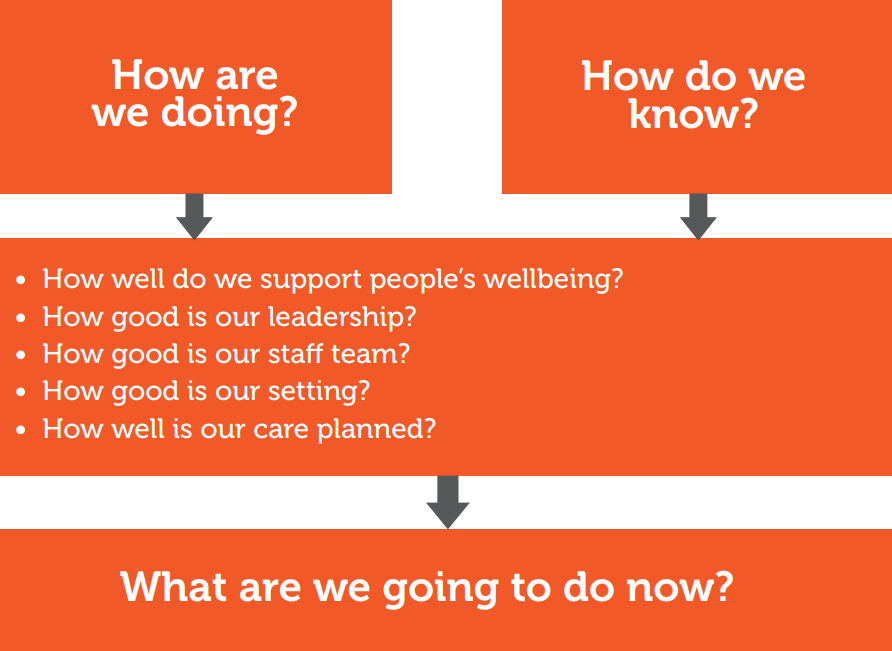Worked Example of the Self-Evaluation Process
(How Good Is Our School?, Education Scotland, 2015, p. 12)
The self-evaluation process is illustrated very effectively using the above diagram.
- It is essential to identify the most appropriate person to lead the self-evaluation process. This could be a Manager, Deputy Headteacher, 0.1 Support Teacher, Early Years Teacher, Senior Early Years Officer or Early Years Officer.
- It is then helpful to decide on a question to guide reflection, for example, ‘How well are we developing children’s language and literacy?’ The Care Inspectorate has developed a three-question approach to self-evaluation.
a) How are we doing?
- Do you understand how good your service is and its impact on the lives of people experiencing it?
b) How do we know that?
- Do you have evidence to show how good you are?
- You can look at performance measures, outcomes and processes, but you should also speak to the people experiencing your service and their families to get their views.
c) What do we plan to do next?
- What is your improvement plan?
- What are your improvement priorities?
- What changes do you plan to test out?
3. Consider which Quality Indicators (QIs) or themes will support the evaluation of your practice.
- The key document to support effective self-evaluation is The Quality Improvement Framework from the Care Inspectorate and Education Scotland. It contains examples of good practice, and many QIs contain challenge questions to support group discussions.
Summary of Quality Indicators from the Quality Improvement Framework:
Using the summary table help to identify relevant quality indicators for your chosen question.
At this stage, it is vital to find out ‘How are we doing?’ Using the examples of good practice from the document will illustrate what good looks like and the challenge questions will help to support group discussions. Record examples of what is working well and discussion points for each Quality Indicator you chose to use.
- “It is vital to illustrate your evaluation with evidence demonstrating ‘How you know?’ how you are doing. This evidence could be features of practice, the progress of children’s learning, and/or feedback from partners”. It might be helpful for practitioners to have more practical examples of how they can gather evidence to show the impact of improvement over time. For example, consider the following for inclusion….
Managers and practitioners could consider the following examples to reflect on “How you know” how you are doing, e.g.
- Environment toolkits completed each term
- Questionnaires
- Floorbook/child’s voice
- Observations of levels of engagement (Leuven Involvement Scale is used at timely intervals)
- Minutes of meetings
- Completing audits around the environment, maths and numeracy, literacy or gender, developmental overviews and collated data from the overviews for emerging literacy, moderation of learning journals by all practitioners. This will provide consistency and quality across the setting when undertaken strategically.
5. Then collaboratively determine what you will do next, who will action the changes, and how you will evaluate their success.
An example of how this can be recorded is shown below.

6. Once you have identified what needs to be done, a more detailed action plan may be required. This is especially important for longer improvement plans. This could be in the form of a Plan, Do, Study, Act (PDSA) cycle. This stage must also be completed as a team, so all practitioners are committed to improving practice and using a consistent approach.
7. As you progress with your improvement plan, gather evidence about its impact on learning and outcomes for children. This stage of reflection is as important as your initial evaluation.
Managers and practitioners should understand the following statement as they consider improving the setting.
- Ensure that improvement targets are SMART (Care Inspectorate Hub-bitesize):
- Specific – what improvement needs to be accomplished?
- Measurable – how will you know you have reached your aim?
- Achievable – is this aim possible to achieve?
- Relevant – does the aim matter to the setting?
- Time-bound – when will the aim be accomplished?
Self-evaluation should be the starting point for development and continuous improvement.
All development and improvements should be linked to the setting SBC’s SIP/SIR and the setting’s quality assurance calendar.




